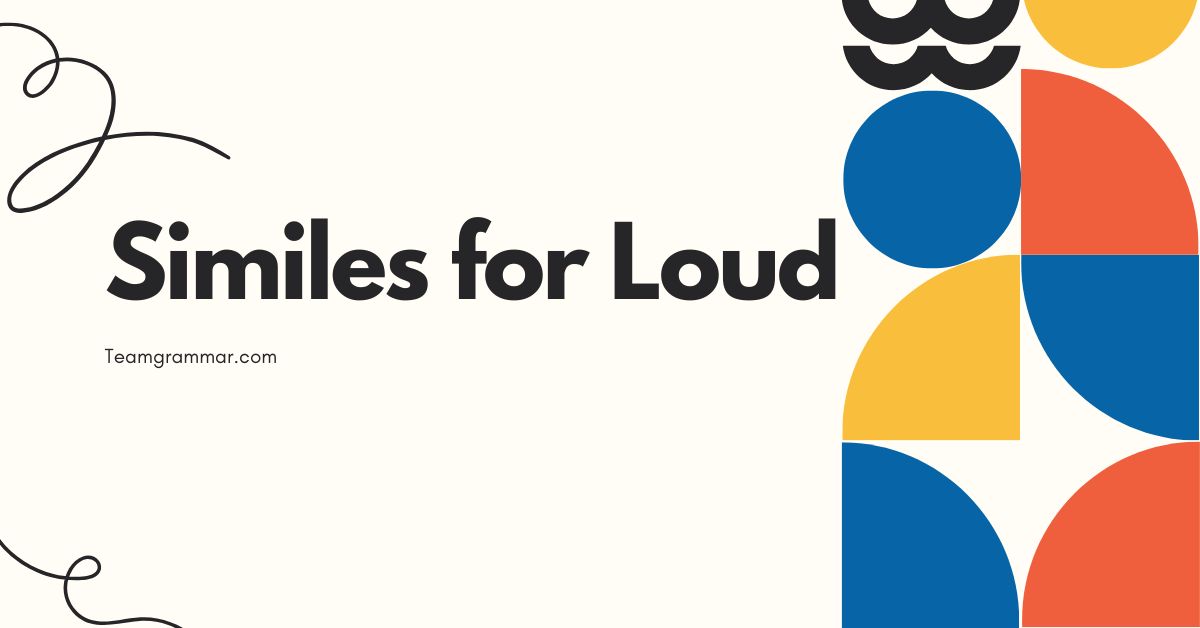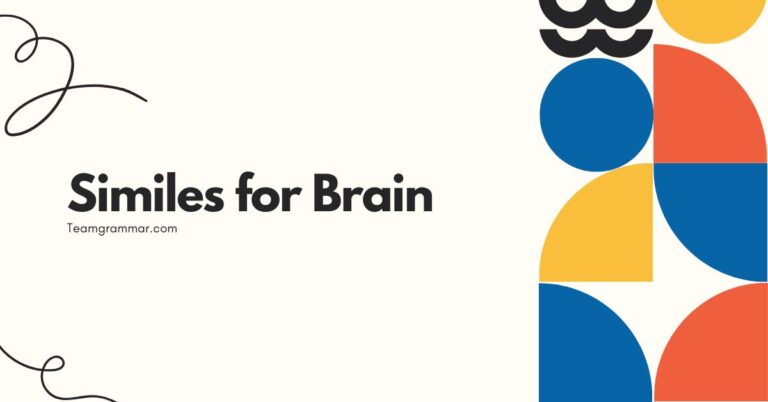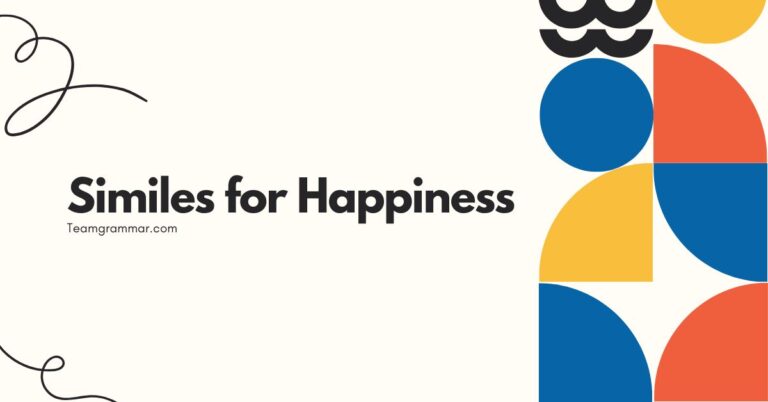35 Similes for Loud: Mastering Figurative Language in English
Understanding and using similes effectively can significantly enhance your descriptive writing and speaking skills. Similes, which compare two unlike things using “like” or “as,” add color, depth, and vividness to your language.
This article focuses specifically on similes related to the concept of “loudness,” providing a comprehensive guide suitable for English language learners, creative writers, and anyone looking to enrich their vocabulary and communication skills. By exploring a variety of similes, this guide will help you articulate the intensity and nature of sounds in a more engaging and imaginative way.
Table of Contents
- Introduction
- Definition of Similes
- Structural Breakdown of Similes
- Types of Loudness and Corresponding Similes
- Examples of Similes for Loud
- Usage Rules for Similes
- Common Mistakes with Similes
- Practice Exercises
- Advanced Topics in Similes
- Frequently Asked Questions (FAQ)
- Conclusion
Introduction
Similes are powerful tools in the English language that can transform ordinary descriptions into vibrant and memorable ones. They allow writers and speakers to draw parallels between seemingly unrelated subjects, creating a deeper understanding and appreciation for the topic at hand.
This article delves into the world of similes specifically used to describe “loudness,” exploring how different comparisons can evoke distinct auditory experiences. Whether you are a student, writer, or simply someone who enjoys playing with language, this guide will provide you with a rich collection of similes and practical advice on how to use them effectively.
Definition of Similes
A simile is a figure of speech that compares two unlike things using the words “like” or “as.” The purpose of a simile is to create a vivid image or convey a particular feeling by drawing a parallel between the two subjects being compared. Similes add depth and color to writing and speech, making descriptions more engaging and memorable.
Thefunctionof a simile extends beyond mere description. It serves to clarify, emphasize, and even evoke emotions in the reader or listener.
By comparing something unfamiliar to something familiar, similes can make complex ideas more accessible. In the context of describing loudness, similes can help us understand the intensity, quality, and impact of a sound by relating it to something else we already understand.
Similes can be used in variouscontexts, from literature and poetry to everyday conversation. They are particularly effective in creative writing, where they can help to paint a picture in the reader’s mind.
In persuasive writing, similes can be used to make an argument more compelling. Even in casual conversation, similes can add a touch of humor or emphasis to your speech.
Structural Breakdown of Similes
The basic structure of a simile consists of three key elements: the subject being described, the linking word (“like” or “as”), and the object to which the subject is being compared. Understanding these elements is crucial for constructing effective and meaningful similes.
Thesubjectis the thing you are describing. In our case, it will be some aspect of “loudness” – a sound, a noise, or an auditory experience.
For example, “the thunder” could be the subject.
The linking word is the word that connects the subject to the object of comparison. The two most common linking words are “like” and “as.” While they are often interchangeable, “as” can sometimes suggest a closer or more direct comparison than “like.”
Theobjectis the thing to which you are comparing the subject. This should be something that shares a quality with the subject but is different enough to create a meaningful comparison.
For example, “a roaring lion” could be the object.
Putting it all together, a simile for loudness might look like this: “The thunder was like a roaring lion.” Here, “thunder” is the subject, “like” is the linking word, and “a roaring lion” is the object of comparison. This simile creates a vivid image of the thunder as something powerful and intense.
Types of Loudness and Corresponding Similes
Loudness is not a monolithic concept. It can manifest in various forms, each with its own unique characteristics.
Understanding these nuances is essential for choosing the most appropriate and effective simile.
Intensity of Sound
This refers to the sheer volume or magnitude of the sound. Similes in this category often compare the sound to something powerful or overwhelming.
Quality of Sound
This refers to the specific characteristics of the sound, such as whether it is harsh, shrill, booming, or deafening. Similes in this category focus on the specific sensory experience of the sound.
Impact of Sound
This refers to the effect the sound has on the listener, such as whether it is jarring, unsettling, or overwhelming. Similes in this category focus on the emotional or physical impact of the sound.
Examples of Similes for Loud
This section provides a comprehensive collection of similes for describing loudness, organized by the different types of loudness discussed above. Each simile is designed to evoke a specific auditory experience and add depth to your descriptions.
Similes for Intensity of Sound
These similes focus on the sheer volume and magnitude of the sound, comparing it to things that are known for their power and intensity.
| Simile | Explanation |
|---|---|
| As loud as a jet engine taking off | Emphasizes the extreme volume and power of the sound. |
| Like a thunderclap directly overhead | Highlights the suddenness and intensity of the sound. |
| As deafening as a rock concert | Conveys the overwhelming and potentially harmful volume. |
| Like the roar of a stadium crowd | Suggests a massive and unified sound. |
| As booming as a cannon firing | Emphasizes the deep, resonant quality of the sound. |
| Like a sonic boom | Indicates an extremely loud and disruptive sound. |
| As ear-splitting as a fire alarm | Highlights the high-pitched and piercing nature of the sound. |
| Like a volcano erupting | Suggests a powerful and explosive sound. |
| As thunderous as a waterfall crashing | Emphasizes the continuous and overwhelming sound. |
| Like the blast of a dynamite explosion | Conveys the sudden and destructive power of the sound. |
| As loud as a freight train rumbling by | Highlights the heavy, rumbling sound and its intensity. |
| Like the shriek of a siren | Suggests a piercing and urgent sound. |
| As intense as a jet breaking the sound barrier | Emphasizes the extreme pressure and force of the sound. |
| Like the sound of a bomb detonating | Highlights the destructive and terrifying nature of the sound. |
| As overwhelming as a chorus of thousands | Conveys the sheer volume and complexity of the sound. |
| Like a tidal wave crashing against the shore | Suggests an unstoppable and immense force. |
| As powerful as a rocket launching into space | Emphasizes the immense energy and force of the sound. |
| Like the earth rumbling during an earthquake | Highlights the deep, unsettling vibration and sound. |
| As loud as a hundred drummers playing at once | Conveys the chaotic and overwhelming nature of the sound. |
| Like the roar of a dragon | Suggests a mythical and terrifying sound. |
| As deafening as standing next to a speaker at a concert. | Highlights the proximity and extreme volume of the sound source. |
| Like the sound of a building collapsing | Conveys the destructive and catastrophic nature of the sound. |
| As loud as a jackhammer breaking concrete | Emphasizes the percussive and repetitive intensity of the sound. |
| Like the scream of a banshee | Suggests a supernatural and chilling sound. |
| As overwhelming as the sound of Niagara Falls | Highlights the continuous and powerful nature of the sound. |
Similes for Quality of Sound
These similes focus on the specific characteristics of the sound, such as its pitch, tone, and timbre. They help to convey the unique sensory experience of the sound.
| Simile | Explanation |
|---|---|
| As shrill as a whistle blowing | Highlights the high-pitched and piercing nature of the sound. |
| Like the grating of fingernails on a chalkboard | Conveys the unpleasant and irritating quality of the sound. |
| As piercing as a dentist’s drill | Emphasizes the sharp and invasive nature of the sound. |
| Like the screech of tires on pavement | Suggests a sudden and jarring sound. |
| As booming as a bass drum | Highlights the deep, resonant quality of the sound. |
| Like the crackle of a campfire | Suggests a warm and comforting sound, even if loud. |
| As tinny as an old radio | Conveys the poor quality and distorted sound. |
| Like the rumble of distant thunder | Suggests a low and ominous sound. |
| As hollow as an empty echo | Emphasizes the lack of substance and depth in the sound. |
| Like the clang of a blacksmith’s hammer | Suggests a sharp and metallic sound. |
| As raspy as a worn-out record | Highlights the rough and uneven quality of the sound. |
| Like the buzz of a swarm of bees | Suggests a constant and irritating sound. |
| As metallic as the crash of cymbals | Emphasizes the sharp, ringing quality of the sound. |
| Like the howl of the wind through a canyon | Suggests a haunting and mournful sound. |
| As crisp as the snap of a twig | Highlights the sharp and clear quality of the sound. |
| Like the drone of an airplane engine | Suggests a monotonous and persistent sound. |
| As gravelly as a smoker’s voice | Emphasizes the rough and textured quality of the sound. |
| Like the jingle of sleigh bells | Suggests a light and cheerful sound, even if loud. |
| As dull as the thud of a dropped book | Highlights the muted and unresonant quality of the sound. |
| Like the hiss of escaping steam | Suggests a sharp and sibilant sound. |
| As smooth as the hum of a well-tuned engine | Highlights the consistent and harmonious quality of the sound. |
| Like the clatter of dishes in a busy restaurant | Suggests a chaotic and disorganized sound. |
| As jarring as the sound of a dropped metal pan | Highlights the sudden and disruptive quality of the sound. |
| Like the whisper of leaves in a storm | Suggests a subtle sound that is still distinct despite the surrounding noise. |
| As sharp as the ping of a tuning fork | Emphasizes the clear and precise quality of the sound. |
Similes for Impact of Sound
These similes focus on the effect the sound has on the listener, such as whether it is jarring, unsettling, or overwhelming. They help to convey the emotional or physical impact of the sound.
| Simile | Explanation |
|---|---|
| As jarring as a sudden alarm | Highlights the disruptive and startling nature of the sound. |
| Like a punch to the gut | Conveys the visceral and overwhelming impact of the sound. |
| As unsettling as a scream in the night | Emphasizes the fear and unease caused by the sound. |
| Like a hammer blow to the head | Suggests a painful and disorienting sound. |
| As overwhelming as a wall of sound | Highlights the sheer intensity and force of the sound. |
| Like a shockwave rippling through the body | Suggests a physical reaction to the sound. |
| As invasive as a constant ringing in the ears | Emphasizes the persistent and inescapable nature of the sound. |
| Like a swarm of bees attacking | Suggests a chaotic and overwhelming sensation. |
| As paralyzing as the roar of a predator | Emphasizes the fear and helplessness induced by the sound. |
| Like a jolt of electricity | Suggests a sudden and intense sensation. |
| As disorienting as being caught in a whirlwind | Highlights the chaotic and confusing nature of the sound. |
| Like being submerged in a sea of noise | Suggests a feeling of being overwhelmed and suffocated by sound. |
| As numbing as prolonged exposure to loud noise | Highlights the desensitizing effect of constant loudness. |
| Like a wave crashing over you | Suggests a feeling of being overwhelmed and powerless. |
| As bewildering as the cacophony of a city street | Emphasizes the chaotic and confusing nature of urban noise. |
| Like being trapped in a reverberating echo chamber | Suggests a feeling of being surrounded and bombarded by sound. |
| As startling as a gunshot in a quiet room | Highlights the sudden and unexpected nature of the sound. |
| Like a sudden plunge into ice-cold water | Suggests a shocking and intense sensation. |
| As terrifying as the sound of approaching footsteps in the dark | Emphasizes the fear and vulnerability induced by the sound. |
| Like a knife twisting in your ear | Suggests a painful and agonizing sensation. |
| As deafening as the silence that follows an explosion | Highlights the contrast between extreme loudness and sudden quiet. |
| Like the feeling of your eardrums about to burst | Suggests the physical discomfort and potential damage caused by excessive loudness. |
| As disturbing as the sound of someone screaming for help | Highlights the emotional distress and urgency conveyed by the sound. |
| Like being inside the bell as it rings | Suggests a feeling of being completely enveloped and vibrated by the sound. |
| As intrusive as a mosquito buzzing in your ear | Emphasizes the irritating and persistent nature of the sound. |
Usage Rules for Similes
While similes are a creative tool, there are certain rules and guidelines to follow to ensure they are used effectively and appropriately. These rules help to avoid clichés, maintain clarity, and create a strong impact.
Be Original:Avoid overused or cliché similes. The goal is to create a fresh and unique comparison that will surprise and engage the reader or listener.
Instead of saying “as loud as a lion,” try something more specific and imaginative, like “as loud as a pride of lions roaring in unison.”
Ensure Relevance:The comparison should be relevant and meaningful. The object of comparison should share a quality with the subject that is being emphasized.
If you are describing the intensity of a sound, compare it to something known for its intensity. If you are describing the quality of a sound, compare it to something with a similar quality.
Maintain Clarity:The simile should be easy to understand. The comparison should be clear and straightforward, avoiding obscure or overly complex references.
The purpose of a simile is to clarify and enhance understanding, not to confuse the reader or listener.
Consider Context:The appropriateness of a simile depends on the context in which it is used. A simile that is effective in one situation may be inappropriate in another.
Consider the tone, audience, and purpose of your writing or speech when choosing a simile.
Use Sparingly:Similes are most effective when used sparingly. Overusing similes can make your writing or speech sound contrived and repetitive.
Use them strategically to highlight key points and create a strong impact.
Common Mistakes with Similes
Even experienced writers and speakers can make mistakes when using similes. Being aware of these common errors can help you avoid them and use similes more effectively.
Using Clichés: Cliché similes are overused and predictable, and they can detract from the impact of your writing or speech. Avoid phrases like “as loud as thunder” or “as deafening as a bomb.” Instead, strive for originality and create your own unique comparisons.
Making Illogical Comparisons:The comparison should make sense and be based on a shared quality. Avoid comparing things that have no logical connection.
For example, saying “the sound was as loud as a flower” is illogical because flowers are not typically associated with loudness.
Being Too Vague:The simile should be specific and descriptive. Avoid using vague or generic comparisons that do not create a clear image.
Instead of saying “the sound was like something loud,” be more specific and say “the sound was like a jet engine taking off.”
Overusing Similes: Using too many similes can make your writing or speech sound contrived and repetitive. Use similes sparingly and strategically to highlight key points and create a strong impact.
Here are some examples of common mistakes and how to correct them:
| Incorrect | Correct | Explanation |
|---|---|---|
| The sound was as loud as thunder. | The sound was like a volcanic eruption. | Avoid clichés; use a more original comparison. |
| The sound was as loud as a feather. | The sound was as loud as a jackhammer. | Ensure the comparison is logical and relevant. |
| The sound was like something loud. | The sound was like a freight train roaring past. | Be specific and descriptive to create a clear image. |
Practice Exercises
These exercises will help you practice using similes to describe loudness. Choose the best simile to complete each sentence, or create your own simile based on the given prompt.
Exercise 1: Multiple Choice
Choose the best simile to complete each sentence.
| Question | Options | Answer |
|---|---|---|
| The explosion was ___________. | A) as loud as a whisper B) as loud as a jet engine C) as loud as a mouse | B) as loud as a jet engine |
| The music was ___________. | A) like the gentle breeze B) like a roaring waterfall C) like a quiet stream | B) like a roaring waterfall |
| The siren was ___________. | A) as shrill as a bird’s song B) as shrill as a tea kettle C) as shrill as a foghorn | C) as shrill as a foghorn |
| The crowd’s cheers were ___________. | A) like a soft murmur B) like a quiet conversation C) like a thunderous wave | C) like a thunderous wave |
| The construction noise was ___________. | A) as quiet as a library B) as grating as fingernails on a chalkboard C) as soothing as a lullaby | B) as grating as fingernails on a chalkboard |
| The car alarm was ___________. | A) as melodic as a symphony B) as piercing as a dentist’s drill C) as calming as ocean waves | B) as piercing as a dentist’s drill |
| The band’s performance was ___________. | A) like a gentle rain B) like a mild breeze C) like a hurricane unleashed | C) like a hurricane unleashed |
| The motorcycle’s engine was ___________. | A) as quiet as a hummingbird B) as booming as a bass drum C) as silent as a shadow | B) as booming as a bass drum |
| The firework’s burst was ___________. | A) like a flickering candle B) like a distant whisper C) like a cannon firing | C) like a cannon firing |
| The baby’s cry was ___________. | A) as soft as a cloud B) as piercing as a smoke alarm C) as gentle as a feather | B) as piercing as a smoke alarm |
Exercise 2: Fill in the Blanks
Complete the sentences with appropriate similes for loudness.
| Question | Answer |
|---|---|
| The music at the concert was ___________. | The music at the concert was as loud as a jet plane taking off. |
| The train’s horn was ___________. | The train’s horn was like the bellow of a raging bull. |
| The construction site’s noise was ___________. | The construction site’s noise was as deafening as a demolition derby. |
| The thunder during the storm was ___________. | The thunder during the storm was like the roar of a thousand lions. |
| The siren of the ambulance was ___________. | The siren of the ambulance was as shrill as a banshee’s wail. |
| The engine of the race car was ___________. | The engine of the race car was like a caged beast trying to break free. |
| The crowd’s reaction to the goal was ___________. | The crowd’s reaction to the goal was as explosive as a dynamite blast. |
| The feedback from the microphone was ___________. | The feedback from the microphone was like nails scratching against a blackboard. |
| The sound of the waterfall was ___________. | The sound of the waterfall was as thunderous as a collapsing mountain. |
| The cheers at the stadium were ___________. | The cheers at the stadium were like the eruption of a dormant volcano. |
Exercise 3: Create Your Own Similes
Write your own similes to describe the following scenarios.
| Scenario | Your Simile |
|---|---|
| Describe the sound of a rock concert. | The sound of the rock concert was like being trapped inside a jet engine. |
| Describe the sound of a car crash. | The sound of the car crash was as jarring as a building collapsing. |
| Describe the sound of fireworks on the Fourth of July. | The fireworks on the Fourth of July were like a symphony of explosions. |
| Describe the sound of a busy construction site. | The construction site sounded as chaotic as a swarm of angry bees. |
| Describe the sound of a train passing by. | The train passing by was as loud as a metal dragon roaring through the night. |
| Describe the sound of a motorcycle speeding down the street. | The motorcycle speeding down the street sounded like a banshee screaming by. |
| Describe the sound of a jet breaking the sound barrier. | The jet breaking the sound barrier was like a sonic boom ripping through the sky. |
| Describe the sound of a tornado approaching. | The tornado approaching sounded as ominous as the earth groaning. |
| Describe the sound of a factory operating at full capacity. | The factory operating at full capacity sounded as relentless as a machine gun firing. |
| Describe the sound of a crowded stadium during a championship game. | The crowded stadium during the championship game sounded like a volcano about to erupt. |
Advanced Topics in Similes
For advanced learners, exploring more complex aspects of similes can further enhance their understanding and usage. This includes understanding the difference between similes and metaphors, using extended similes, and exploring the cultural context of similes.
Similes vs. Metaphors:While both similes and metaphors are figures of speech that compare two unlike things, they do so in different ways.
A simile uses “like” or “as” to make an explicit comparison, while a metaphor implies a comparison without using these words. For example, “the sound was like a roaring lion” is a simile, while “the sound was a roaring lion” is a metaphor.
Extended Similes:An extended simile is a simile that is developed over several lines or sentences. This allows for a more detailed and nuanced comparison, creating a richer and more vivid image.
For example, instead of saying “the sound was like a jet engine,” you could say “the sound was like a jet engine, roaring with a deafening intensity that shook the ground and vibrated through your bones.”
Cultural Context:The effectiveness of a simile can depend on the cultural context in which it is used. Some comparisons may be more meaningful or relevant to certain cultures than others.
Being aware of these cultural nuances can help you choose similes that are appropriate and effective for your target audience.
Frequently Asked Questions (FAQ)
Here are some frequently asked questions about similes and their usage.
- What is the difference between a simile and a metaphor?
A simile uses “like” or “as” to make an explicit comparison between two unlike things, while a metaphor implies a comparison without using these words. For example, “the sound was like a roaring lion” is a simile, while “the sound was a roaring lion” is a metaphor.
- Can I use a simile and a metaphor in the same sentence?
Yes, you can use both similes and metaphors in the same sentence, but it’s essential to ensure that they complement each other and don’t create confusion. For instance, “The artist’s voice, like a gentle stream, was a soothing balm to the soul” uses both a simile and a metaphor to enhance the description.
- How can I make my similes more original?
To make your similes more original, avoid clichés and overused comparisons. Instead, try to think of unique and unexpected comparisons that will surprise and engage the reader or listener. Draw inspiration from your own experiences and observations.
- Is it okay to use similes in formal writing?
Yes, similes can be used in formal writing, but they should be used sparingly and strategically. Choose similes that are appropriate for the tone and audience of your writing, and avoid using overly informal or colloquial comparisons.
- How many similes should I use in a piece of writing?
There is no set number of similes that you should use in a piece of writing. The number of similes you use will depend on the length, style, and purpose of your writing. However, it is generally best to use similes sparingly and strategically to avoid overusing them.
- What is an extended simile?
An extended simile is a simile that is developed over several lines or sentences. This allows for a more detailed and nuanced comparison, creating a richer and more vivid image. It provides a deeper exploration of the similarities between the two things being compared.
- How do I choose between using “like” and “as” in a simile?
While “like” and “as” are often interchangeable, “as” can sometimes suggest a closer or more direct comparison than “like.” Choose the word that best conveys the intended relationship between the two things being compared. Consider the nuance and emphasis you want to create.
- Can a simile be too complex or obscure?
Yes, a simile can be too complex or obscure if it is difficult for the reader or listener to understand. The purpose of a simile is to clarify and enhance understanding, not to confuse the audience. Choose comparisons that are clear, relevant, and easy to grasp.
- How do similes enhance descriptive writing?
Similes enhance descriptive writing by creating vivid images, evoking emotions, and adding depth to your descriptions. They allow you to draw parallels between seemingly unrelated subjects, making your writing more engaging and memorable. They help to paint a picture in the reader’s mind and bring your descriptions to life.
- Are similes only used to describe physical things or can they describe emotions and abstract concepts?
Similes are versatile and can be used to describe physical things, emotions, and abstract concepts. They can add depth and clarity to descriptions of emotions, making them more relatable and understandable. For example, you can describe sadness as “like a heavy weight on your heart” or joy as “as bright as the summer sun.”
Conclusion
Mastering the art of using similes can significantly enhance your communication skills, allowing you to express yourself more vividly and effectively. By understanding the structure, types, and usage rules of similes, you can craft compelling descriptions that engage your audience and bring your writing to life.
Remember to be original, relevant, and clear in your comparisons, and avoid common mistakes like using clichés or making illogical connections. With practice and attention to detail, you can become a master of similes and elevate your language to new heights.
As you continue to explore the world of similes, remember to pay attention to the language used by others and to experiment with your own creative comparisons. The more you practice, the more natural and intuitive it will become to use similes effectively.
So go forth and let your language roar like a lion, or perhaps, be as piercing as a well-aimed arrow – the choice is yours!







